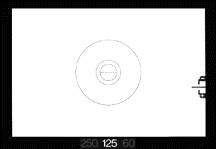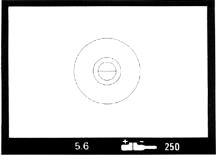Viewing/Metering Functions
 |
|
|
Viewfinder of Nikkormat FT3 |
Viewfinder of Nikon F2A |
The Nikkormat FT3 is fitted with a fixed pentaprism finder offering convenient eye-level viewing and composing. The image, viewed through the mounted lens via the camera's built-in reflex mirror, appears unreversed and erect on the focusing screen for the fullest ease of viewing and focusing. The finder coverage is approximately 92% of the picture area registered on the film, and corresponds to almost the entire picture area of a mounted color slide - but doesn't covers 100% as with the pro models. The focusing screen fitted in the camera is similar to the Type K screen available for F2 Nikon cameras; it has a central split-image rangefinder surrounded by a microprism collar and a matte Fresnel field. For focusing, the photographer can use either the central rangefinder or microprism collar, or any part of the matte screen to meet the requirements of the particular lens or shooting situation. In total, the FT3 viewfinder, when combined with fully automatic Nikkor lenses, offers a very good images for comfortable, sure viewing and pinpoint focusing.
 |
The Nikkormat FT3's viewfinder also houses the camera's thru-the-lens (TTL) exposure measurement system. The finder meter measures the total image area, but favors the 12mm diameter central portion representing one-eighth of the total field; with this system, approximately. 60% of the meter reading is taken in only the central reading, with the additional 40% representing the value for the remainder of the field. The center-weighted measurement technique employed by Nikon on Nikkormat FT3 may not be compared with today's high tech metering like multi-segments/Matrix metering or the awesome user alterable metering capability of the F5, but it can assure the most balanced readings for the widest range of lighting conditions and for equally balanced readings in both vertical and horizontal format shooting. All meter readings are cross-coupled with the camera's shutter speed and aperture controls to ensure full consideration of the lens/camera settings in use. The range of the camera's metering system is a fairly weak EV3 to EV17, but it is sufficient to cover operation from f/1.4 at 1/4 second to f/11 at 1/1000 second with a 50mm f/1.4 lens and ASA 100 film. |
Metering accuracy is much
improved over a wider range of temperatures and environmental friendlier with the
use of a widely accessible 1.5V (Earlier Nikkormats were using abandon mercury cells
but can use subsitutes like zinc oxide cells available not from popular outlets)
silver-oxide battery as the power source.
Inside the finder, the viewfinder displays essential information concerning both
the shutter speed selected and the metering setting. On the scale visible just below
the viewfield are found three shutter speeds corresponding to the selected value
(in the center), the next faster speed (to the left) and the next slower speed (to
the right); to ensure quick recognition, the center value is in white, with the others
in yellow. Also, to the right and within
the field is found the metering indicator; this display consists of the moveable
meter needle and a bracketing frame with a plus and minus defining, respectively,
overexposure and underexposure.
 |
How to turn on the meter ? Most older Nikons used the film advance lever as the on-off switch for the meter. If I can recall the Nikon EM was the first ? Or the Nikon F3 uses light touch half depress on shutter release button to activate the meter. |
Anyway, this is not too unfamiliar for many Nikon users. The camera's metering circuit, powered by the silver-oxide battery in the base of the camera (This is a much improved feature, as earlier models like FT and FTn, the battery is under the mirror box, you have to use the mirror lock up lever to flip the reflex mirror upward first), is turned on by the operation of the film-advance lever. As the lever is moved outward to the 20° stand-off position, the meter is turned on; this condition is indicated by the red meter ON index dot visible on the camera body.
Viewing/Metering Part
One &
Part
Two
Mechanism around the F-mount
The Copal Square
shutter and relative functions
Film Transport | Flash Photography | Spec
| Back | to main Index Page of Nikkormat FT3
| Back |
to Main Index
Page of Nikkormats
 |
The Eyes of Nikon:- |
Fisheye-Nikkor Lenses - Circular | Full Frame | Ultrawides Lenses - 13mm15mm18mm20mm | Wideangle Lenses - 24mm28mm35mm |
Standard Lenses - 45mm 50mm 58mm | Telephoto Lenses - 85mm105mm135mm180mm & 200mm |
Super-Telephoto Lenses - 300mm 400mm 500mm 600mm 800mm 1200mm |
Special Application lenses:
Micro-Nikkor Lenses - 50mm~55mm -60mm 85mm -105mm 200mm Micro-Zoom 70-180mm
Perspective Control (PC) - 28mm 35mm PC-Micro 85mm
Dedicated Lenses for Nikon F3AF: AF 80mm f/2.8 | AF 200mm f/3.5 EDIF
Depth of Field Control (DC): 105mm 135mm
Medical Nikkor: 120mm 200mm
Reflex-Nikkor Lenses - 500mm 1000mm 2000mm
Others: Noct Nikkor | OP-Nikkor | UV Nikkor 55mm 105mm | Focusing Units | Bellows-Nikkor 105mm 135mm
Nikon Series E Lenses: 28mm35mm50mm100mm135mm | E-Series Zoom lenses: 36~72mm75~150mm70~210mm
MF Zoom-Nikkor Lenses: 25~50mm | 28~45mm | 28~50mm | 28~85mm | 35~70mm | 36~72mm E | 35~85mm | 35~105mm | 35~135mm |
35~200mm | 43~86mm | 50~135mm | 50~300mm | 70~210mm E | 75~150mm E | 80~200mm | 85~250mm |
100~300mm | 180~600mm | 200~400mm | 200~600mm | 360~1200mm | 1200~1700mm
Tele-Converters: TC-1 | TC-2 | TC-200 | TC-201 | TC-300 | TC-301 | TC-14 | TC-14A | TC-14B | TC-14C | TC-14E | TC-16 | TC-16A | TC-20E
![]()
Nikon F
| Nikon F2 |
Nikon
F3
| Nikon F4 |
Nikon
F5
| Nikon F6 |
Nikkormat / Nikomat |
Nikon FM
| Nikon FE/ FA | Nikon EM/FG/FG20 | Nikon Digital SLRs | Nikon - Other models
MIR Supports for Photographic Community: Various Message Boards/Community
Forums
Nikon
F-series|
Nikon
F2-series|
Nikon
F3-series|
Nikon F4-series| Nikon
F5-series|Nikkormat/Nikomat-series
Nikon FM-series|Nikon
FE-series|Nikon
FA|Nikon
Digital
SLR
series|Various
Nikon
Models|Nikkor
Optic
-shared
Others:- Free Trade Zone - Photography| Free Trade Zone - Business Community |Free To Zouk - Photographic Community
Apple's Mac Public Community Message Board | Windows based PC &
Apple/Mac
Public Community Trade Exchange Centre
Recommended links to understand
more technical details related to the Nikkor F-mount and production Serial Number:
http://rick_oleson.tripod.com/index-153.html by: my friend, Rick Oleson
http://www.zi.ku.dk/personal/lhhansen/photo/fmount.htm by: Hansen, Lars Holst
http://www.mir.com.my/rb/photography/hardwares/nikonfmount/lens2.htm
http://www.photosynthesis.co.nz/nikon/serialno.html
About
this photographic
site.
Home - Photography
In Malaysia
![]()
Copyright
© 1998.
HIURA Shinsaku ® ; Nikomat ML, Japan,
in collaboration with leofoo ®. MIR Web Development Team.
* Credit: A
Great thanks to Mr Denis Pleic for his volunteering
effort to reedit content and and patching some grammatical mistakes found in this
section of the PIM site. Miss
Rissa (Marketing) & Edward
(Techical) of Shriro Malaysia, distributor of Nikon cameras in Malaysia, in providing
so many useful inputs to make this site possible. Mr Hong,
Ipoh for lending me his FT2 to take some of the images used in this site. This site
is created for his eldest son, Yuen who has picked up his father's hobby and
the FT-2. My friend, John Walls from Florida, US for his images of the FTn
body and the Zoom Nikkor
43-86mm.
[Left Brain][Right brain][Home-MIR] [Invention][Art & Design][Clubs]
[Portfolios][On assignments] [Trading room][Knowledge & Resources] [Free-trade-zone][Thoughts & opinions][Links]
